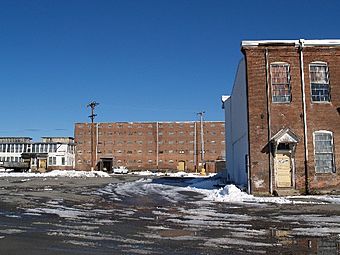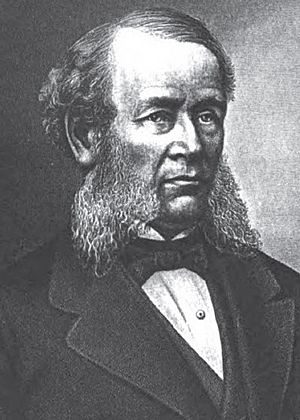Whittenton Mills Complex facts for kids
Quick facts for kids |
|
|
Whittenton Mills Complex
|
|
 |
|
| Location | Taunton, Massachusetts |
|---|---|
| Built | 1805 |
| Architectural style | Early Commercial |
| MPS | Taunton MRA |
| NRHP reference No. | 84002275 |
| Added to NRHP | July 5, 1984 |
The Whittenton Mills Complex is a historical site in Taunton, Massachusetts. It is located on Whittenton Street, right by the Mill River. This area has been used for making things since 1670. Back then, James Leonard built a metal shop called a forge there.
The first textile mill, which made cloth, was built in 1805. It grew bigger throughout the 1800s. The complex was added to the National Register of Historic Places in 1984. Today, it is home to different small businesses.
In October 2005, the site became famous when its old wooden dam, built in 1832, almost broke. This happened after a lot of rain. More than 2,000 people had to leave their homes for several days. Workers quickly used large rocks to make the dam safe again. There were plans to remove the dam completely and help the river go back to its natural state.
In 2008, parts of the movie Shutter Island were filmed here. The scenes showed a concentration camp from World War II.
Contents
What is the History of Whittenton Mills?
From 1670 to 1805, the Leonard family ran a metal forge on the west side of the Mill River. This area was first called Whittington. In 1805, a group named Crocker, Bush, and Richmond started a nail factory there.
In 1807, they added a second floor to the factory to make cotton yarn. A fire destroyed this factory on November 9, 1811. But it was quickly rebuilt, becoming a three-story building. Thomas Bush left the company in 1812, and it became Crocker and Richmond. The first machines that could weave cloth using power were brought in during 1818.
How Did the Taunton Manufacturing Company Start?
In early 1823, Samuel Crocker and Charles Richmond created the Taunton Manufacturing Company. They worked with rich investors from Boston. This new company ran many different businesses. They made copper, iron, machinery, and cotton and wool textiles. They had several locations across Taunton.
In 1824, a new mill was built at Whittenton. It was on the east side of the river. James K. Mills & Company from Boston managed this new mill.
Who Was Willard Lovering?
A second mill was added in 1831-1832. This mill was made of stone and had seventy weaving machines. These machines made fine cotton goods. James K. Mills & Company took full ownership of the property in 1835. A year later, Willard Lovering joined the company. He made many improvements to the way things were made.
The first mill from 1811 was destroyed by fire in January 1839. A new mill was built soon after. The 1832 mill was also made bigger in 1840. Lovering and his sons bought the property after a financial crisis in 1857. This crisis caused James K. Mills & Company to go out of business.
Lovering retired in 1864. He gave control of the mills to his three sons: Charles L., William Croad, and Henry Morton Lovering. By 1883, the company was officially named the Whittenton Manufacturing Company. The factory covered about 15 acres. It had over 400,000 square feet of space for making products. They made many cotton goods, like ginghams, dress fabrics, shirtings, flannels, and denims. The factory used five large steam engines and water wheels for power.
In 1881, the Old Colony Railroad built a train connection to the Whittenton Mills. The next year, the train line was extended to Raynham. A new weaving shop was added to the mills in 1884.
By 1917, the Whittenton Manufacturing Company was worth $600,000. Arthur Lyman was the president. It had many machines for spinning yarn and weaving cloth. It produced ginghams and blankets.
What is the Recent History of Whittenton Mills?
In February and March 2008, some parts of the movie Shutter Island were filmed here. Many actors were needed for these scenes. They showed a Nazi concentration camp.
A flea market opened at the site in 2009. It stayed open until January 2012. On January 31, 2012, the owner, David Murphy, shared new plans. A company from China planned to invest $25 million in the complex. The idea was to turn the 42-acre site into homes and businesses.




